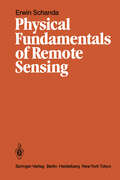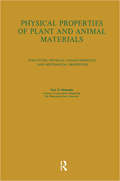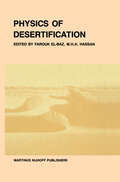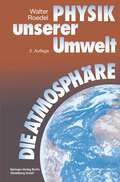- Table View
- List View
Phylogenetics of Bees
by Rustem Abuzarovich Ilyasov Hyung Wook KwonBees are flying insects of the order Hymenoptera closely related to wasps and ants. The ancestors of bees are assumed to be predatory wasps, which switched to pollen consumption. Further, bees co-evolved with flowering plants and divided into several species according to climatic conditions. Widely known bees are western bees Apis mellifera, and eastern bees Apis cerana. This book sheds light on features of evolution, phylogenesis, speciation, adaptation to environment, and taxonomy of bees. It will be of particular relevance to evolutionists, geneticists, taxonomists, ecologists, population geneticist, and breeders.
Physical Activity in Natural Settings: Green and Blue Exercise
by Aoife A. Donnelly Tadhg E. MacIntyreExercise interactions with green and blue spaces offer low-cost, non-invasive solutions to public health challenges—particularly around mental health and obesity—and issues around environmental sustainability. Physical Activity in Natural Settings brings together multi-disciplinary, international research on physical activity, health and the natural environment, offering evidence-based guidance on implementing nature-based solutions at individual, patient and population levels. Divided over four sections, the book assesses the current research landscape, explores the underlying psychological and physiological mechanisms of the benefits of green exercise, details applied examples of physical activity in natural settings, and suggests future directions for research and practice. It features contributions from experts from around the world and covers topics including: Self-determination, nature and wellbeing Visual cognition and multisensory stimuli Nature’s role in growing resilience Physical education and nature Mindfulness and green exercise Positive psychology and pro-environmental behaviour Timely and prescient, and showcasing real-life examples of green exercise prescription, Physical Activity in Natural Settings is fascinating and important reading for any students or researchers in the psychology or physiology of physical activity and health, physical education or outdoor studies, and policy-makers and health professionals.
Physical Activity in Natural Settings: Green and Blue Exercise
by Aoife A. Donnelly Tadhg E. MacIntyreExercise interactions with green and blue spaces offer low-cost, non-invasive solutions to public health challenges—particularly around mental health and obesity—and issues around environmental sustainability. Physical Activity in Natural Settings brings together multi-disciplinary, international research on physical activity, health and the natural environment, offering evidence-based guidance on implementing nature-based solutions at individual, patient and population levels. Divided over four sections, the book assesses the current research landscape, explores the underlying psychological and physiological mechanisms of the benefits of green exercise, details applied examples of physical activity in natural settings, and suggests future directions for research and practice. It features contributions from experts from around the world and covers topics including: Self-determination, nature and wellbeing Visual cognition and multisensory stimuli Nature’s role in growing resilience Physical education and nature Mindfulness and green exercise Positive psychology and pro-environmental behaviour Timely and prescient, and showcasing real-life examples of green exercise prescription, Physical Activity in Natural Settings is fascinating and important reading for any students or researchers in the psychology or physiology of physical activity and health, physical education or outdoor studies, and policy-makers and health professionals.
Physical and Chemical Weathering in Geochemical Cycles (Nato Science Series C: #251)
by A. Lerman M. MeybeckProceedings of the NATO Advanced Study Institute, Aussois, France, September 4-15, 1985
Physical Fundamentals of Remote Sensing
by Erwin SchandaTen years ago the author, together with eight co-authors, edited a textbook Remote Sensing for Environmental Sciences within the series on Ecological Studies of Springer-Verlag. At that time there were not yet many books available on remote sensing. The decade that has elapsed was marked by a spectacular development in this field. This development took place in many directions: by widening the areas of application, by improvements of the methods and the sensors, by the introduction of new versatile platforms, but also by deepening the knowledge of the theoretical foundations. This evolution improved the ability to explain the interaction between electromagnetic radia tion and natural objects, which, in its turn, allowed for better modelization and for the creation of refined mathematical tools in the processing of remotely sensed data and in the determination of the physical status of remote objects. The community of research workers engaged in development and use of remote sensing methods changed accordingly from a modest group of scientists in the early 1970's to a considerable branch of specialized and interdisciplinary activity. The training of students had to be adapted to cope with the increasing number of people entering this new field and with the increasing quality of the material to be presented.
The Physical Geography of Georgia (Geography of the Physical Environment)
by Nana Bolashvili Vazha NeidzeThis book is the first to give a comprehensive and detailed overview of the complete physical geography of Georgia in English. It discusses natural and environmental conditions, hydrology, geomorphology, landscapes, and resources and elaborates issues of environmental protection, natural hazards, resource potentials, tourism and many other topics of this multifaceted country.This volume will appeal to researchers, educators and students in the fields of natural and environmental sciences, geography, geology, regional studies and related areas.
The Physical Geography of Mongolia (Geography of the Physical Environment)
by Batchuluun YembuuThis book gives the most detailed and comprehensive physico-geographical overview of the very unique country of Mongolia. The country offers diverse geographical features and natural landscapes combined with a long history. This book offers integrated and systematical research on the geophysical characteristics of Mongolia with an academic orientation. It provides the readers with general knowledge of the physical geography of Mongolia as well as new results of the latest research. The volume consists of 11 chapters, each written by field experts, with contributions from scientific researchers from Mongolia.The topics covered: geological and geomorphological characteristics and processes, landscapes and landforms, climate and climate change, hydrology, glaciers and permafrost, soils, environmental changes, biodiversity and many other aspects of physical geography in Mongolia.The book appeals to researchers and students of geography and related fields and can serve as a guide for field trips to Mongolia or basic literature for research projects.
Physical Intelligence: The Science of Thinking Without Thinking
by Scott Grafton'An instant classic' Michael S. Gazzaniga, author of The Consciousness InstinctWhat is it that stops us from walking into walls or off cliffs? How do you pick the right moment to cross a busy road Or decide if you can drive through a storm? What helps you discover a shortcut to a familiar route?The answer is PHYSICAL INTELLIGENCESometimes, you need to do it to know it. Your hands have to be on the steering wheel to learn the feel of slipping tyres. You need to be watching the traffic to judge the best moment to cross the road. Everything we do, from changing a lightbulb to navigating unknown terrain relies on physical intelligence, our oldest and most important form of cognition. Physical intelligence was the key development in human evolution; thinking evolved first and foremost so we could do things. It has been the key to our survival against all the odds for so long that it has become instinctive, and continues to underpin our every action, from the ordinary (walking down a street) to the extraordinary (winning a race) and beyond. Renowned neuroscientist, doctor and keen climber, Scott Grafton was fascinated to discover how physical intelligence's most important components were laid bare, away from civilisation. In this book he takes you on a journey to explore the hidden depths of this silent, ruthless intellect we all possess. Drawing on the latest scientific discoveries and research, experiences with patients, and Professor Grafton's own gripping stories of survival in the wilderness, Physical Intelligence explains the science behind our most overlooked ability and takes a fascinating and vital look at how we could and should use it better.
Physical Methods in Agriculture: Approach to Precision and Quality
by Jirí Blahovec Miroslav KutílekThe frrst attempts to use physical methods in agriculture can be found in nineteenth century as a necessary component of farm and food machinery. There were mechanics, electricity and physical chemistry that were the first physical disciplines used in agriculture and food industry. In the same time period the studies on physical properties of soils started to be one of main topics of soil science. The twentieth century was a century of research on physical properties of agromaterials. The physical properties of agromaterials have been studied e. g. in the USA, where a big role has been played by ASAE (1907), and in the Soviet Union where the special Institute of Agrophysics was founded (1932) by Academician Ioffe. The ASAE's activity was enlarged in 1960s and 1970s, especially with the role playing by the Mohsenin's group and its followers. At that time the Institute of Agrophysics of Polish Academy of Sciences was founded in Lublin and conferences on physical methods in agriculture began to be organised. The participants of the last conference - "Physical Methods in Agriculture - Approach to Precision and Quality", held on August 27-30, 2001, have prepared the basis for this book. Part of the conference participants decided to enlarge their conference papers to be more general and more instructive in relation to further development of the science. New papers prepared under this deciSion were reviewed, discussed and revised, repeatedly, to be presented in this book.
Physical Processes in Estuaries
by Job Dronkers Wim Van LeussenIn Physical Processes in Estuaries the present day knowledge of the physics of transport phenomena in estuaries and their mathematical treatment is summarized: It is divided into following parts: - Water movements in estuaries - Estuarine fronts and river plumes - Internal waves and interface stability - Fine sediment transport, aggregation of particles, settling velocity of mud flocs - Sedimentation and erosion of fine sediments. For each topic an up-to-date review and recommendations for future research are given, followed by results of original studies. Since estuarine environments are the first to be threatened by urbanization and industrial exploitation this book is an important tool for students and researchers of environmental problems as well as for consultants and water authorities.
Physical Properties of Plant and Animal Materials: v. 1: Physical Characteristics and Mechanical Properties
by Nuri N. MohseninThis collection of essays by both Western and East European experts examines the efforts to develop strategies for dealing with the environmental crisis both by governments and at the grassroots level of newly emerging green movements.
Physical Stresses in Plants: Genes and Their Products for Tolerance
by Stefania Grillo Antonella LeoneThe workshop "Genes and their products for tolerance to physical stresses in plants" was held in Maratea, Italy, from 24-27 September 1995. As one of a series of activity launched by the European Science Foundation (ESF) Network "Cell Stress Genes and their Protein Products", the workshop was the only one entirely devoted to research in the plant field. Around one hundred participants from fourteen different countries enjoyed a lively meeting in an atmosphere of sunny Mediterranean weather. A total of twenty-eight speakers from universities and research institutes were invited to present the most recent results of their research. The workshop was divided into eight sessions, namely heat, cold, salt, drought, oxidative stress, light stress, a conclusive session for recommendations and a poster session. The results reported in this workshop broadly showed the rapid progress made in the understanding of the molecular mechanisms underlying basic aspects of the plant response to environmental stresses.
Physics and Chemistry of the Arctic Atmosphere (Springer Polar Sciences)
by Alexander Kokhanovsky Claudio TomasiThis book presents current knowledge on chemistry and physics of Arctic atmosphere. Special attention is given to studies of the Arctic haze phenomenon, Arctic tropospheric clouds, Arctic fog, polar stratospheric and mesospheric clouds, atmospheric dynamics, thermodynamics and radiative transfer as related to the polar environment. The atmosphere-cryosphere feedbacks and atmospheric remote sensing techniques are presented in detail. The problems of climate change in the Arctic are also addressed.
The Physics of Climate Change
by Lawrence M. Krauss'Brilliant and fundamental, this is the necessary book about our prime global emergency' Ian McEwan The news is full of hotly debated and divergent claims about the impacts and risks of climate change. Lawrence Krauss, one of the world's most respected physicists and science popularizers, cuts through the confusion by succinctly presenting the underlying science of climate change.The Physics of Climate Change provides a clear, accurate and accessible perspective of climate science and the risks of global inaction. Krauss's narrative explores the history of how scientists progressed to our current understanding of the Earth's climate and its future. Its generous complement of informative diagrams and illustrations allows readers to assess which climate predictions are securely based on analysis of empirical data, and which are more speculative.The Physics of Climate Change is required reading for anyone interested in understanding humanity's role in the future of our planet.
Physics of desertification
by M. H. A.Hassan FaroukEl-BazDeserts are parts of the Earth that receive little or no rain; 25 cm or less per year. The physical processes that act upon these parched lands are vastly different from those that shape the more humid parts of the terrestrial landmasses. In the desert, wind is a major agent of erosion and transportation. As the results of recent space missions have indicated, this is also true in the case of the planet Mars. Thus, our understanding of desert processes sheds light on fundamental planetary processes that may apply on any planetary body that is enveloped by a windy atmosphere. An understanding of the physical layout of arid lands, and the nature of processes that initiate changes therein is also fundamental to thoughtful utilization of these lands for the benefit of mankind. It is with this in mind that we prepared this book for publication. We believe that the collection of articles in this book will be useful to scientists who are interested in desert landforms and processes, and to planners of economic develop ment of arid lands. The book also serves as a guide for students as to the state of our knowledge in this field as well as to the topics that require additional research.
Physics of Societal Issues: Calculations on National Security, Environment, and Energy (Undergraduate Texts In Contemporary Physics)
by David HafemeisterThis book provides the reader with essential tools needed to analyze complex societal issues and demonstrates the transition from physics to modern-day laws and treaties. This second edition features new equation-oriented material and extensive data sets drawing upon current information from experts in their fields. Problems to challenge the reader and extend discussion are presented on three timely issues: • National Security: Weapons, Offense, Defense, Verification, Nuclear Proliferation, Terrorism• Environment: Air/Water, Nuclear, Climate Change, EM Fields/Epidemiology• Energy: Current Energy Situation, Buildings, Solar Buildings, Renewable Energy, Enhanced End-Use Efficiency, Transportation, Economics Praise for the first edition:"This insight is needed in Congress and the Executive Branch. Hafemeister, a former Congressional fellow with wide Washington experience, has written a book for physicists, chemists and engineers who want to learn science and policy on weapons, energy, and the environment. Scientists who want to make a difference will want this book."Richard Scribner, first Director, Congressional Science andEngineering Fellow Program, AAAS "Hafemeister shows how much one can understand about nuclear weapons and missile issues through simple back-of-the-envelope calculations. He also provides compact explanations of the partially successful attempts that have been made over the past 60 years to control these weapons of mass destruction. Hopefully, Physics of Societal Issues will help interest a new generation of physicists in continuing this work."Frank von Hippel, Professor, Princeton, former Assistant Director,National Security, White House, OSTP "Energy policy must be quantitative. People who don't calculate economic tradeoffs often champion simplistic hardware. ‘The solution is more... nuclear power, or electric cars, or photovoltaics, etc.’ Some simple physics will show that the true solution matches supply and demand as an ‘integrated resource plan.’ Physics of Societal Issues is a good place to begin this journey."Arthur Rosenfeld, former California Energy Commissioner,Professor-emeritus, U. of California-Berkeley
Physics of the Terrestrial Environment, Subtle Matter and Height of the Atmosphere: Conceptions of the Atmosphere and the Nature of Air in the Age of Enlightenment
by Eric ChassefiereNo synopsis available
Physics of the Terrestrial Environment, Subtle Matter and Height of the Atmosphere: Conceptions of the Atmosphere and the Nature of Air in the Age of Enlightenment
by Eric ChassefiereThe discovery, in the middle of the 17th century, of both the weight of air and the law governing its elasticity transformed the status of the atmosphere from that of a purely mathematical object to that of a complex and highly variable physical system.In the context of rapidly intensifying experimentation and observation, the nature of the atmosphere was therefore the subject of a host of hypotheses, which 18th century scholars tried to reconcile with a coherent physical approach. In particular, this was achieved by the conceptualization of invisible or “subtle” materials, thought to be closely linked to atmospheric stratification.Subtle matter was introduced, largely to reconcile contradictory results concerning the estimation of the height of the atmosphere. These estimations were based on different methods, mainly using the observation of meteors and the refracted and reflected light of stars.Taking as its common thread the question of the height of the atmosphere, which was omnipresent in the texts at the time, this book traces the history of the discovery of the atmosphere and the many questions it generated.
Physik unserer Umwelt: Die Atmosphäre
by Walter RoedelDas vorliegende Buch verfolgt zwei Ziele. Es dient zunächst der Einführung in die allgemeine Physik der Atmosphäre und macht das Funktionieren des Systems Atmosphäre verständlich; darüber hinaus bietet es einen Überblick über umweltrelevante Aspekte der atmosphärischen Physik.
Physik unserer Umwelt: Die Atmosphäre
by Walter RoedelDas vorliegende Buch verfolgt zwei Ziele. Es dient zunächst der Einführung in die allgemeine Physik der Atmosphäre und macht das Funktionieren des Systems Atmosphäre verständlich; darüber hinaus bietet es einen Überblick über umweltrelevante Aspekte der atmosphärischen Physik.
Physik unserer Umwelt: Die Atmosphäre
by Walter RoedelAus einer zweisemestrigen Vorlesung über die Physik der Atmosphäre im Rahmen des Wahlfaches Umweltphysik hervorgegangen, ist das Buch bewußt als Lehrbuch konzipiert. Es verfolgt zwei miteinander verzahnte Ziele: 1. Das Funktionieren des Systems Atmosphäre verständlich machen; diesem Zweck dienen Abschnitte über den Strahlungshaushalt, über die Energetik und Dynamik der Atmosphäre, über Zirkulationen, über Niederschlagsbildung, über den Wasserhaushalt und Ähnliches. 2. Aspekte der atmosphärischen Physik und der Meteorologie herausarbeiten, die in einem breitgefaßten Sinn umweltrelevant sind. Hierzu dienen eine umfangreiche Darstellung von Diffusion und Austausch, besonders in den bodennahen Schichten, mehrere Abschnitte oder Kapitel über das Verhalten von Spurenstoffen, mit Betonung auf strahlungsrelevanten Spurengasen und auf Schwebeteilchen, und schließlich die Diskussion von Klima-Entwicklungen und von Klima-Modellen. Durch die große Zahl von Literatur- und Quellenangaben wird die weitere Arbeit erleichtert. Das Buch richtet sich an Studenten und Lehrer der Physik und der gesamten Geowissenschaften.
Physik unserer Umwelt: Die Atmosphäre
by Walter Roedel Thomas WagnerDas Buch basiert auf einer zweisemestrigen Vorlesung an der Universität Heidelberg über die Physik der Atmosphäre. Der Autor erklärt einerseits das System Atmosphäre und vermittelt andererseits umweltrelevante Aspekte. Die Neuauflage wurde zum Teil grundlegend überarbeitet. So wurden für die Kapitel zu Spurenstoffen und zur Klimamodellierung die neuesten Forschungserkenntnisse eingearbeitet, das Kapitel über Aerosole um Abschnitte zu deren chemischer Bedeutung ergänzt. Mit umfangreichem Register sowie ausführlichen Quellen- und Literaturangaben.
Physiological Adaptations for Breeding in Birds
by Tony D. WilliamsPhysiological Adaptations for Breeding in Birds is the most current and comprehensive account of research on avian reproduction. It develops two unique themes: the consideration of female avian reproductive physiology and ecology, and an emphasis on individual variation in life-history traits. Tony Williams investigates the physiological, metabolic, energetic, and hormonal mechanisms that underpin individual variation in the key female-specific reproductive traits and the trade-offs between these traits that determine variation in fitness. The core of the book deals with the avian reproductive cycle, from seasonal gonadal development, through egg laying and incubation, to chick rearing. Reproduction is considered in the context of the annual cycle and through an individual's entire life history. The book focuses on timing of breeding, clutch size, egg size and egg quality, and parental care. It also provides a primer on female reproductive physiology and considers trade-offs and carryover effects between reproduction and other life-history stages. In each chapter, Williams describes individual variation in the trait of interest and the evolutionary context for trait variation. He argues that there is only a rudimentary, and in some cases nonexistent, understanding of the physiological mechanisms that underpin individual variation in the major reproductive life-history traits, and that research efforts should refocus on these key unresolved problems by incorporating detailed physiological studies into existing long-term population studies, generating a new synthesis of physiology, ecology, and evolutionary biology.
Physiological Adaptations for Breeding in Birds
by Tony D. WilliamsPhysiological Adaptations for Breeding in Birds is the most current and comprehensive account of research on avian reproduction. It develops two unique themes: the consideration of female avian reproductive physiology and ecology, and an emphasis on individual variation in life-history traits. Tony Williams investigates the physiological, metabolic, energetic, and hormonal mechanisms that underpin individual variation in the key female-specific reproductive traits and the trade-offs between these traits that determine variation in fitness. The core of the book deals with the avian reproductive cycle, from seasonal gonadal development, through egg laying and incubation, to chick rearing. Reproduction is considered in the context of the annual cycle and through an individual's entire life history. The book focuses on timing of breeding, clutch size, egg size and egg quality, and parental care. It also provides a primer on female reproductive physiology and considers trade-offs and carryover effects between reproduction and other life-history stages. In each chapter, Williams describes individual variation in the trait of interest and the evolutionary context for trait variation. He argues that there is only a rudimentary, and in some cases nonexistent, understanding of the physiological mechanisms that underpin individual variation in the major reproductive life-history traits, and that research efforts should refocus on these key unresolved problems by incorporating detailed physiological studies into existing long-term population studies, generating a new synthesis of physiology, ecology, and evolutionary biology.





















